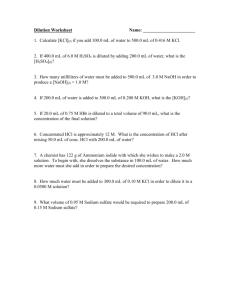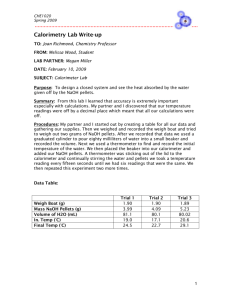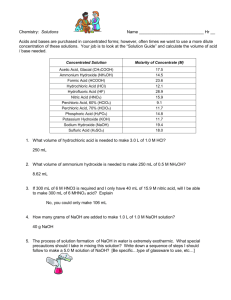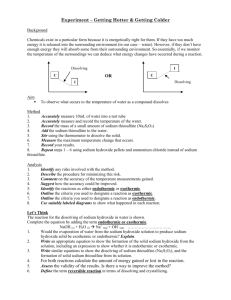File
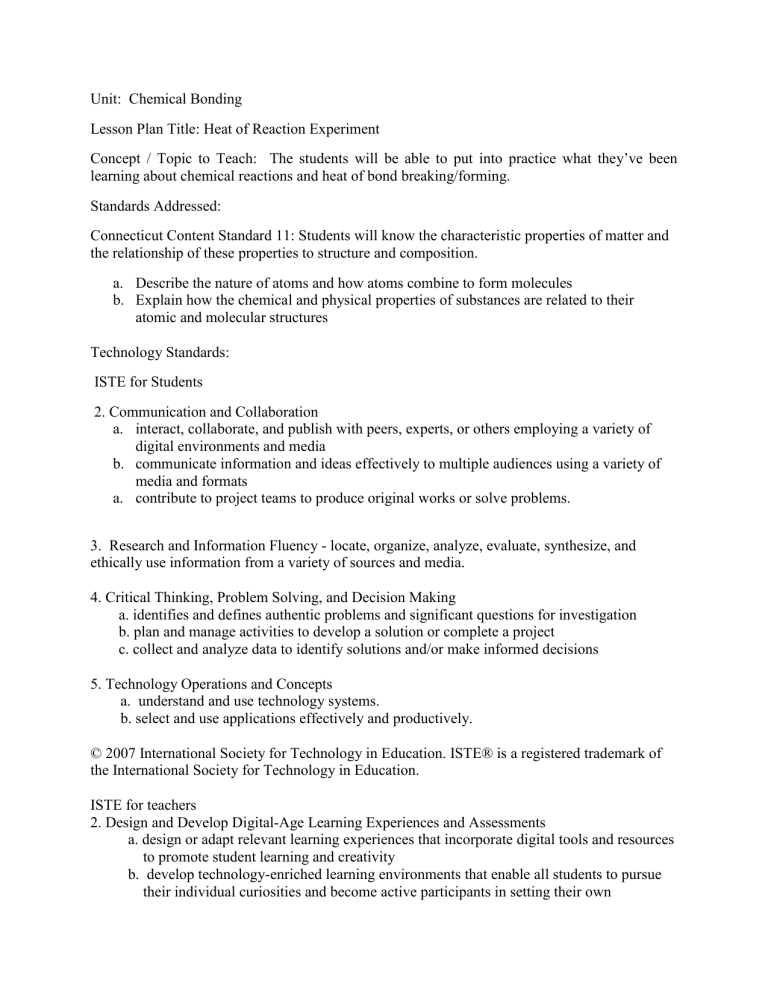
Unit: Chemical Bonding
Lesson Plan Title: Heat of Reaction Experiment
Concept / Topic to Teach: The students will be able to put into practice what they’ve been learning about chemical reactions and heat of bond breaking/forming.
Standards Addressed:
Connecticut Content Standard 11: Students will know the characteristic properties of matter and the relationship of these properties to structure and composition. a.
Describe the nature of atoms and how atoms combine to form molecules b.
Explain how the chemical and physical properties of substances are related to their atomic and molecular structures
Technology Standards:
ISTE for Students
2. Communication and Collaboration a.
interact, collaborate, and publish with peers, experts, or others employing a variety of digital environments and media b.
communicate information and ideas effectively to multiple audiences using a variety of media and formats a.
contribute to project teams to produce original works or solve problems.
3. Research and Information Fluency - locate, organize, analyze, evaluate, synthesize, and ethically use information from a variety of sources and media.
4. Critical Thinking, Problem Solving, and Decision Making a. identifies and defines authentic problems and significant questions for investigation b. plan and manage activities to develop a solution or complete a project c. collect and analyze data to identify solutions and/or make informed decisions
5. Technology Operations and Concepts
a. understand and use technology systems.
b. select and use applications effectively and productively.
© 2007 International Society for Technology in Education. ISTE® is a registered trademark of the International Society for Technology in Education.
ISTE for teachers
2. Design and Develop Digital-Age Learning Experiences and Assessments
a. design or adapt relevant learning experiences that incorporate digital tools and resources
to promote student learning and creativity
b. develop technology-enriched learning environments that enable all students to pursue
their individual curiosities and become active participants in setting their own
educational goals, managing their own learning, and assessing their own progress
c. customize and personalize learning activities to address students’ diverse learning styles,
working strategies, and abilities using digital tools and resources
d. provide students with multiple and varied formative and summative assessments aligned
with content and technology standards and use resulting data to inform learning and
teaching
3. Model Digital-Age Work and Learning
a. model and facilitate effective use of current and emerging digital tools to locate,
analyze, evaluate, and use information resources to support research and learning
Copyright © 2008, ISTE (International Society for Technology in Education), 1.800.336.5191
(U.S. & Canada) or 1.541.302.3777 (Int’l), iste@iste.org, www.iste.org. All rights reserved.
General Goal(s): The goal of this lesson is to teach the students about exothermic and endothermic reactions and how this is a part of the heat of reaction previously learned.
Specific Objectives: Students will work together in groups to run a simple coffee calorimetry experiment to understand exothermic and endothermic reactions. This will help them to understand the meaning of heat of reactions and also how the bond energy they learned about in the previous lesson works. In this lesson, students will be required to practice writing out chemical reactions and work on figuring out how to draw enthalpy tables.
Required Materials: This lesson will require the use of computers so that the students can graph their observations on the changes in temperature over time. The lab should be stocked with thermometers, 50 mL beakers, coffee cups, stir plates, and HCl, NaOH, citric acid, and sodium bicarbonate.
Anticipatory Set (Lead-In): Students will have just learned about bond energy so this experiment will be lead in by a brief overview of common bond energies that they will need to know. The idea of exothermic and endothermic reactions will be covered in terms of explaining how chemical reactions take place with the idea of bond energies. The experiment will also be introduced.
Step-By-Step Procedures:
1.) Bond energy will be reviewed
2.) I will cover the topic of enthalpy and how to predict heat of reactions using bond breaking and bond forming
3.) Then, after this, bond energies for the reactions occurring in this experiment will be covered and explained
4.) We will go over the experiment and work together to explain the reactions that are occurring within the coffee cup calorimeter
5.) I will do an example of one of the experiments that they will not be required to do and I will also go over how to use excel to make graphs and tables so that they can quantify and make conclusions based on their data
6.) The students will be required to estimate the type of reaction each experiment will produce and also hypothesize which experiment will give off the greatest heat and which will give off the lowest amount of heat
7.) For the rest of the class period, the students will follow the experiment and make observations
8.) Once they’ve completed the experiment, they will each go on to a computer and graph the change in temperature over change in time. They will observe which experiment gave off the most heat and which gave off the least. They will then need to write out each of the chemical reactions and classify each reaction as endothermic or exothermic.
Plan for Independent Practice: For homework, students will continue to work on the experiment if they aren’t done making the graphs in excel. They will also be required to write up a lab report stating their observations and relating these observations to what they have learned about bond energies. In this, they will need to call upon their understanding about enthalpy changes and the types of reactions they have learned about.
Closure (Reflect Anticipatory Set): The students will continue to work on their graphs and charts for the reactions. I will go over what they need to include in the lab reports and answer any remaining questions.
Assessment Based on Objectives: The lab report will be the assessment for the students.
Adaptations (For Students with Learning Disabilities): Since each group is working together, students with disabilities will be helped out by their peers. Slides will also be available online through blackboard if they wish to look at them again.
Extensions (For Gifted Students): The students are all required to do the same work through this lab, but if students think they have a very good grasp on the material, then they will be given a worksheet with more chemical reactions on them and they will have to work through the problems with what they know about bond breaking and forming to predict the enthalpy of the reaction and if the reaction will be exothermic or endothermic.
Possible Connections to Other Subjects: Chemical reactions often give off a lot of heat which is experienced in everyday life. This experiment will allow them to connect the material into real work practice.
Experiment:
Determining the Heat of Neutralization
Skills Assessed: Data collection, data Processing, presentation, conclusion, evaluation
Objective: To determine the heat of neutralization of a strong acid/strong base reaction.
Introduction: In every chemical reaction, energy is either absorbed or released. If energy is released in the form of heat, we say that the reaction is exothermic. The amount of heat released depends upon the nature and amount of reactants and products. If the heat is calculated per mole of a reactant, then results may be compared to one another. In this experiment, you will measure the amount of heat released in a strong acid/strong base reaction between HCl and NaOH:
HCl (aq) + NaOH (aq)
H
2
O (l) + NaCl (aq)
You will calculate the amount of heat released per mole of HCl by performing the reaction in a coffee cup calorimeter. All calorimeters have the same basic components. They are insulated to prevent loss or gain of heat energy between the calorimeter and its surroundings. The simple calorimeter you will use in this experiment is made of a heat-insulating plastic foam material.
Calorimeters contain a heat sink that can absorb or provide the energy for the process under study. The most common material used as a heat sink for calorimeters is water, because of its simple availability and large heat capacity. Calorimeters also must contain some device for the measurement of temperature, because it is from the temperature change of the calorimeter and its contents that the magnitude of the heat flow is calculated. Your simple calorimeter will use an ordinary thermometer for this purpose. To determine the heat flow for a process, the calorimeter typically is filled with a weighed amount of water. The temperature of the water in the calorimeter is monitored during the process to be measured. From the mass of water in the calorimeter and the temperature change of the water, the quantity of heat transferred in the process can be determined. The calorimeter for this experiment is pictured in Figure 15-1. It consists of two nested plastic foam coffee cups and a cover, with thermometer and stirring wire inserted through holes punched in the cover. As you know, plastic foam does not conduct heat well and will allow little heat to be lost to the room, so that we can calculate the heat exchanged and thus the specific heat of the metal.
Safety:
1. Wear safety glasses at all times in the laboratory.
2. Use tongs or a towel to protect your hands when handling hot glassware.
3. Hydrochloric acid is an irritant at the concentration used in this experiment. If you spill acid on yourself, immediately flush the affected area with water for 2-3 minutes and notify the teacher. If acid should get into your eyes, begin flushing your eyes with water immediately and continue doing so for at least 20 minutes.
4. If acid is spilled on the laboratory bench or floor, neutralize the spill with solid sodium bicarbonate, NaHCO
3
, before wiping it up with sponges or paper towels. The acid will be neutralized when bubbles of gas no longer form after addition of the sodium bicarbonate. If you need to dispose of a small quantity of acid, pour it down the drain.
5. Sodium hydroxide is a very caustic material that can cause severe skin burns. Do not handle the sodium hydroxide with your fingers under any circumstances. Eye burns caused by sodium hydroxide are progressive: what at first appears to be a minor irritation can develop into a severe injury unless the chemical is completely flushed from the eye. If sodium hydroxide comes in contact with the eye, flush the eye with running water for at least 15 minutes. Notify the teacher immediately. If sodium hydroxide is spilled on another area of the body, flush the affected area continuously with running water for a minimum of 10 minutes or until the skin no longer feels
“soapy.”
Materials:
2 plastic foam cups with covers thermometer wire for stirrer
Thermometer
50 mL beakers
1.0
M HCl
1.0
M NaOH
0.5 M NaOH
0.5 M HCl
Distilled Water
Citric acid
Baking soda
Procedure:
1.
Record all data and observations directly in your notebook in ink.
2.
Write out the reactions you are going to perform before doing any experiment.
3.
Based on what you know about bond energy (breaking and forming) write out your expected enthalpy change
4.
Nest two similar-sized plastic foam coffee cups for use as the calorimeter chamber. If the cups have been rinsed with water, dry them out.
5.
Obtain a lid that tightly fits the coffee cups. Using the paper punch, make two small holes in the lid. Make one hole near the center of the lid for the thermometer and one hole to the side for the stirring wire. Assemble the stirring wire and thermometer as indicated in Figure 15-1.
6.
Measure 50 mL HCl into your coffee cup calorimeter.
7.
Measure 50 mL NaOH with a graduated cylinder and set aside.
8.
Measure and record the temperature of the HCl solution in the coffee cup calorimeter
9.
Add the NaOH solution, cap the calorimeter, stir vigorously and record the highest temperature reached taking the temperature every fifteen seconds until the temperature reaches a maximum
10.
Discard the solution into the sink and rinse the cup and thermometer with water.
11.
Repeat for the reactions:
Reaction 1: The dissolving of solid sodium hydroxide in water.
NaOH(s)
Na
+
(aq) + OH
-
(aq) + heat
Reaction 2: The reaction of solid sodium hydroxide with dilute hydrochloric acid.
NaOH(s) + H
+
(aq) + Cl
-
(aq)
Na
+
(aq) + Cl
-
(aq) + H
2
O
Reaction 3: The reaction of sodium hydroxide solution with dilute hydrochloric acid solution.
Na
+
(aq) + OH
-
(aq) + H
+
(aq) + Cl
-
(aq)
Na
+
(aq) + Cl
-
(aq) + H
2
O
Reaction Four (Endothermic):
H
3
C
6
H
5
O
7
(aq) + 3 NaHCO
3
(s) --> 3 CO
2
(g) + 3 H
2
O(l) + NaC
6
H
5
O
7
(aq)
1.
Place 25 mL of citric acid solution in a styrofoam coffee cup. Use the thermometer to take the initial temperature of the acid.
2.
Stir in 15 g of baking soda (sodium bicarbonate). Track the change in temperature every fifteen seconds until a final temperature is reached.
3.
Note: this reaction is endothermic so the reaction is complete when the temperature reaches room temperature again.
Data Collection:
Create a chart, according to IB criteria, for the data generated during this experiment. Create a graph to visually represent your results.
Data Analysis:
Process your data, draw conclusions and evaluate your data according to IB criteria.
The accepted value for the heat of neutralization per mole of a strong acid (like HCl) is -56.3 kJ mol
-1
. (Exothermic)
Experiment From: http://www.isstavanger.no/high/ClassPages/Chem/ib%201%20chem/unit%206/Heat%20of%20N eutralization%20Lab.pdf


